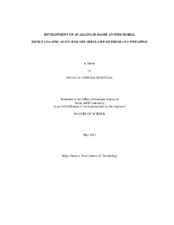| dc.description.abstract | In the last few years, especially in the developed countries, an increment in demand for fresh-cut fruit by the consumers of all ages has occurred. This increase is mainly due to the importance that people are giving to the consumption of fresh, healthy, and low-calorie food products. Fresh-cut pineapple (Ananas comosus) is one of the fruits that consumers can eat quickly and still enjoy its benefits; however, its shelf-life is very short (7 days).
A means to preserve all the natural and beneficial components of fresh-cut pineapple is coating the fruit with an edible material, a coating. This coating acts as a barrier against moisture loss and gas exchanges and can be a carrier of other components like antimicrobials, which can help to extend the shelf-life of the fresh-cut fruit.
The main objective of this study was to develop an edible coating with an antimicrobial agent for fresh-cut pineapple and to determine its effectiveness in extending shelf-life and preserving fruit quality attributes.
Different treatments consisted of several concentrations of sodium alginate (0.5%, 1%, and 2%); beta-cyclodextrin, trans-cinnamaldehyde (antimicrobial), pectin, and calcium chloride were tested for formulation of the edible coating. The layer-by-layer technique with a dipping method was used to coat the fruits. Pineapples were properly cleaned with a chlorine solution (300 ppm) and triangular prisms (3.6 cm per side) were cut using a triangular cutter. The length of the triangular prisms was adjusted to 2.54 cm using a small knife measured with a ruler.
Color, texture, pH, degrees Brix (total soluble solids), acidity, vitamin C, moisture content, and weight loss, were monitored every 3 to 4 days for 15 days. Microbiological tests (aerobic plate counts, psychrotrophic counts, and yeast and molds counts) were performed to determine the effectiveness of the antimicrobial compound.
In terms of microbiological and physicochemical quality attributes, the coating improved the shelf-life of the fresh-cut pineapple up to 12 days compared to the control (fresh-cut pineapple without the coating) which only lasted 7 days at 4 degrees C. Color, texture and pH, were better preserved in the treated (coated) fruit compared to controls (uncoated). Different concentrations of the solutions in the formation of the coating had different results in terms of the preservation of the quality attributes of the fruit. Antimicrobial coatings with a concentration of alginate of 1% and 2% (w/w), pectin 2% (w/w) and calcium chloride 2% (w/w) presented a satisfactory formulation to preserve fruit quality attributes like moisture content, help to control juice leakage, and avoid microbial growth. Antimicrobial coating with 1% of alginate (w/w), 2% of pectin (w/w), 2% of calcium chloride (w/w) and 2% of antimicrobial compound (w/w) was the best formulation.
This research demonstrates the feasibility of an alginate-based antimicrobial edible coating, which acts as a carrier of antimicrobial compounds for fresh-cut pineapple. | en |


